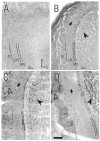Developmental changes in odor-evoked activity in rat piriform cortex
- PMID: 17204372
- PMCID: PMC1810345
- DOI: 10.1016/j.neuroscience.2006.11.049
Developmental changes in odor-evoked activity in rat piriform cortex
Abstract
In adult rats, odor-evoked Fos protein expression is found in rostrocaudally-oriented bands of cells in anterior piriform cortex (APC), likely indicating functionally distinct subregions, while activated cells in posterior piriform cortex (PPC) lack apparent spatial organization. To determine whether these patterns are present during early postnatal life, and whether they change during development, Fos expression was assessed following acute exposure to single aliphatic acid odors in developing rats beginning at postnatal day 3 (P3). In the olfactory bulb, Fos-immunoreactive cells were present in the granule cell, mitral cell and glomerular layers at the earliest ages examined. Cells immunopositive for Fos were clustered in areas previously reported as active in response to these odors. In piriform cortex, activation in layers II/III shared some features with that seen in the adult; in APC, rostro-caudally oriented bands of Fos-positive cells alternated with bands relatively free of label, while labeled cells were found dispersed throughout PPC. However, in P3-P7 animals, Fos-positive cells in APC were found in a central rostro-caudally oriented band that was flanked by two bands relatively free of Fos-positive cells. This contrasted with the adult pattern, a central cell-poor band flanked by cell-rich bands, which was observed beginning at P10. These results suggest that subregions of APC visualized by odor-evoked Fos expression are active and functionally distinct shortly after birth. Changes in activity within these subregions during early postnatal development coincide with a shift toward adult-like olfactory learning behavior in the second postnatal week, and may play a role in this behavioral shift.
Figures




References
-
- Bolles RC, Woods PJ. The ontogeny of behavior in the albino rat. Animal Behavior. 1965;12:427–441.
-
- Brunjes PC, Illig KR, Meyer EA. A field guide to the anterior olfactory nucleus (cortex) Brain Research Reviews. 2005;50:305–335. - PubMed
-
- Camp LL, Rudy JW. Changes in the categorization of appetitive and aversive events during postnatal development of the rat. Developmental Psychobiology. 1988;21:25–42. - PubMed
-
- Ekstrand JJ, Domroese ME, Feig SL, Illig KR, Haberly LB. Immunocytochemical analysis of basket cells in rat piriform cortex. J Comp Neurol. 2001a;434:308–328. - PubMed
-
- Ekstrand JJ, Domroese ME, Johnson DMG, Feig SL, Knodel SM, Behan M, Haberly LB. A new subdivision of anterior piriform cortex and associated deep nucleus with novel features of interest for olfaction and epilepsy. J Comp Neurol. 2001b;434:289–307. - PubMed
Publication types
MeSH terms
Substances
Grants and funding
LinkOut - more resources
Full Text Sources

